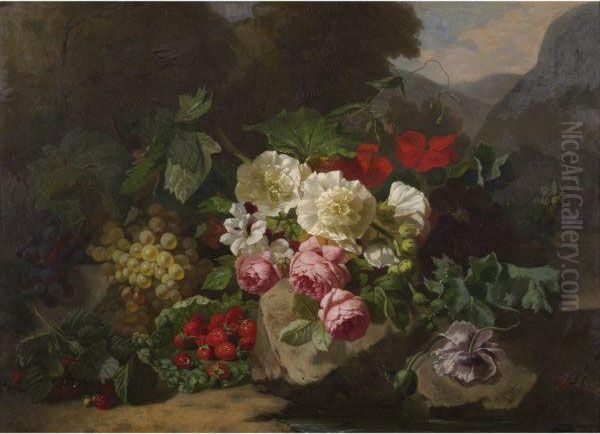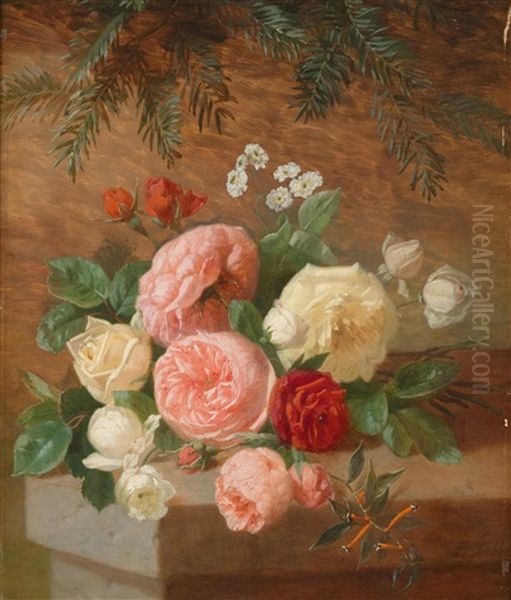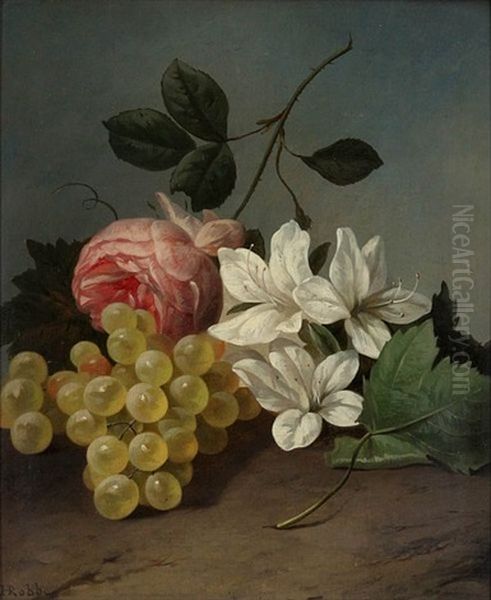Henri Robbe (1807-1899) stands as a notable figure in the rich tapestry of 19th-century Belgian art, particularly celebrated for his exquisite still life paintings. His artistic journey, marked by a transition from music to the visual arts, culminated in a legacy of works that continue to charm viewers with their meticulous detail, vibrant coloration, and profound appreciation for the beauty of the natural world. This exploration delves into the life, style, and context of Henri Robbe, an artist whose dedication to his chosen genre earned him recognition in his time and a lasting place in the annals of still life painting.
From Parisian Melodies to Belgian Canvases
Born in Kortrijk (Courtrai), Belgium, in 1807, Henri Robbe's early professional life took him down a different artistic path. He initially established himself as a music teacher in Paris, a city then, as now, a vibrant hub of European culture and artistic innovation. The precise reasons and timing for his shift from the auditory art of music to the visual art of painting are not extensively documented, but this transition speaks to a versatile artistic sensibility and a compelling pull towards the canvas.
This change in career was not uncommon in an era where artistic boundaries were perhaps more fluid, and individuals often pursued multiple creative outlets. However, Robbe's dedication to painting, once embraced, became the defining feature of his professional life. He returned to Belgium, specifically Brussels, which was a significant artistic center in its own right, fostering a thriving community of painters. It was here that he would develop his distinct style and contribute to the Belgian artistic landscape.
The Artistic Milieu of 19th-Century Belgium
To understand Henri Robbe's work, it is essential to consider the artistic environment of 19th-century Belgium. Following its independence in 1830, Belgium experienced a surge in national pride, which was often reflected in the arts. Historical painting, championed by figures like Gustave Wappers, Nicaise de Keyser, and Hendrik Leys, enjoyed considerable prestige, depicting grand scenes from Belgian history. Romanticism was a dominant force in the early to mid-century, infusing art with emotion and drama.

Alongside these grand narratives, genre painting and portraiture also flourished. Artists like Alfred Stevens gained international acclaim for their elegant depictions of contemporary women and society, while François-Joseph Navez was a leading figure in Neoclassicism and portraiture. The Belgian art scene was dynamic, with institutions like the Brussels Salon providing crucial platforms for artists to exhibit their work and gain recognition. The Royal Academy of Fine Arts in Brussels and Antwerp were also pivotal in training generations of artists.
Within this context, still life painting, while perhaps not always carrying the same academic weight as historical painting, maintained a consistent appeal. It drew upon a long and distinguished tradition, particularly from the Dutch Golden Age masters of the 17th century, and continued to attract artists who found expressive potential in the careful arrangement and depiction of inanimate objects.
The Enduring Allure of Still Life
Still life painting, or "nature morte" in French, has a venerable history in European art. From the illusionistic depictions in Roman frescoes to the symbolic arrangements of the Dutch Golden Age, where artists like Jan van Huysum and Rachel Ruysch achieved breathtaking realism in their floral compositions, the genre has offered artists a unique space for technical display and thematic exploration. The 18th-century French painter Jean-Baptiste-Siméon Chardin elevated still life with his quiet, intimate portrayals of everyday objects, imbuing them with a profound sense of dignity.
In the 19th century, still life continued to evolve. While some artists adhered to traditional, highly finished styles, others began to explore new approaches influenced by Realism and, later, Impressionism. For Henri Robbe, the tradition of meticulous realism, combined with a Romantic sensibility for the beauty of nature, seems to have been a guiding principle. His choice to specialize in floral and fruit still lifes placed him in a lineage of artists who celebrated the ephemeral beauty of the natural world.
Henri Robbe's Artistic Focus: Flowers and Fruits
Henri Robbe's oeuvre is predominantly characterized by his dedication to still life, with a particular emphasis on flowers and fruits. These subjects, perennial favorites in the still life tradition, allowed him to showcase his remarkable skill in capturing texture, color, and light. His compositions often feature lush bouquets of roses, tulips, and other blossoms, frequently accompanied by arrangements of ripe fruits, all rendered with an impressive degree of botanical accuracy.

His paintings are not mere transcriptions of nature; they are carefully constructed compositions designed to delight the eye and evoke a sense of abundance and transient beauty. The arrangements are often opulent, with flowers spilling from vases or fruits artfully placed on ledges or in bowls. This focus aligns him with other notable 19th-century flower painters, such as the French artist Henri Fantin-Latour, who also gained fame for his sensitive and realistic floral still lifes, or his Belgian contemporary Jean Robie, another celebrated specialist in this genre.
The choice of flowers and fruits also carried symbolic potential, a legacy from earlier still life traditions. Roses could symbolize love or transience, while various fruits might allude to abundance, fertility, or the seasons. While it is not always clear to what extent Robbe consciously embedded complex symbolism in his works, the inherent beauty and the suggestion of life's fleeting nature are palpable.
Mastery of Detail and Technique
A hallmark of Henri Robbe's style is his meticulous attention to detail and his refined oil painting technique. He possessed an exceptional ability to render the delicate translucency of petals, the velvety texture of a rose, the dewy freshness of grapes, or the polished gleam of a ceramic vessel. This precision suggests a keen observational skill and a patient, disciplined approach to his craft.
His use of color was rich and harmonious. He adeptly captured the subtle gradations of hue within a single flower and balanced the vibrant colors of his bouquets against more subdued backgrounds or the earthy tones of fruits. Light plays a crucial role in his paintings, often illuminating the central arrangement to highlight textures and create a sense of depth and volume. This careful manipulation of light and shadow contributes to the lifelike quality of his subjects.
The compositions, while often abundant, are generally well-balanced. He arranged his elements to create a pleasing visual rhythm, guiding the viewer's eye through the intricate details of the scene. The surfaces upon which his subjects rest – often stone ledges or wooden tables – are also rendered with care, providing a stable and convincing grounding for the floral and fruit displays.
Representative Works and Their Characteristics

Several works by Henri Robbe exemplify his style and thematic concerns. One notable example, often cited, is a "Still life with flowers and fruits." This painting typically depicts a lavish arrangement, perhaps featuring blooming roses and tulips alongside a variety of fruits, possibly displayed in or around an ornate container like a blue ceramic bowl or a "turntable bowl" (compotier). Such a work would showcase his ability to contrast the soft textures of petals with the firm, glossy surfaces of fruit and the cool smoothness of porcelain.
Another titled work, "Rosen auf einer Steinmauer" (Roses on a Stone Wall), suggests a slightly different compositional approach, perhaps more rustic or integrated with an architectural element. This title evokes an image of roses cascading over or placed against a stone backdrop, allowing for a play of textures between the organic softness of the flowers and the ruggedness of the stone. Such a setting could also imply a garden scene, bringing a hint of the outdoors into the still life arrangement.
While specific details of many individual paintings might require direct viewing or more specialized art historical texts, the general characteristics of his work point to a consistent dedication to realism, careful composition, and a celebration of natural beauty. His still lifes often include common props of the genre, such as elegant vases, simple earthenware, or perhaps a draped cloth, all contributing to the overall aesthetic and verisimilitude of the scene. One might also find, in line with broader still life conventions, elements like glassware, cutlery, or even books and musical instruments, though flowers and fruit remained his primary focus. These elements, when present, could add layers of meaning, perhaps hinting at domesticity, intellectual pursuits, or the passage of time, themes often explored by artists like the Danish-born Johan Laurentz Jensen, who also worked in Brussels and was renowned for his floral pieces.
Exhibitions and Recognition
Henri Robbe was an active participant in the art world of his time, and his work gained public recognition through exhibitions. He is known to have exhibited at the prestigious Salon des Artistes Français in Brussels. The Salons were critical for artists in the 19th century, serving as the primary venues for showcasing their work to critics, collectors, and the public. Participation and success in these Salons could significantly enhance an artist's reputation and career.
A significant accolade in Robbe's career was the bronze medal he received at the 1900 Exposition Universelle (World's Fair) in Paris. Although this award came very late in his life (indeed, if his death year is 1899, this award might be posthumous or there's a slight discrepancy in dates, or it refers to a different Robbe – however, the provided information links it to him), such international recognition was a testament to the quality and appeal of his work. World's Fairs were monumental events that showcased achievements in industry, science, and the arts from around the globe, and an award from such an event was a considerable honor. This suggests his art resonated beyond Belgian borders.
The fact that his works, such as "Still life with flowers and fruits" and "Rosen auf einer Steinmauer," are noted in auction records and art historical listings further indicates their circulation and appreciation within the art market, both during his lifetime and subsequently.
Contemporaries and the Wider Art World
Henri Robbe worked during a vibrant period in European art. In Belgium, alongside the aforementioned historical painters and genre specialists, there were other artists dedicated to still life. Besides Jean Robie, one might consider artists like David de Noter and his family, who were also known for their detailed still lifes. The influence of the Dutch and Flemish Old Masters remained strong in this genre.
Beyond Belgium, the art world was undergoing significant transformations. In France, the Realist movement, championed by artists like Gustave Courbet, challenged academic conventions by focusing on everyday subjects and unidealized depictions. Later in Robbe's career, Impressionism emerged, revolutionizing the way artists approached light, color, and momentary perception, with figures like Claude Monet and Pierre-Auguste Renoir leading the charge. While Robbe's meticulous, traditional style seems distinct from these more avant-garde movements, he was undoubtedly aware of the broader artistic currents of his time.
His dedication to a more traditional, highly finished style of still life painting provided a counterpoint to these newer trends, catering to a taste for naturalistic beauty and technical skill that never fully waned. His contemporaries in the still life genre across Europe, like Fantin-Latour in France or flower painters in other national schools, collectively contributed to the continued vitality of this artistic form. Even landscape painters of the era, such as those from the Barbizon School in France or Belgian landscape artists like Hippolyte Boulenger, shared a common interest in the close observation of nature, albeit expressed in different genres. The animal painter Eugène Verboeckhoven, a highly successful Belgian artist, often incorporated lush, detailed foliage into his pastoral scenes, showing a similar attention to natural detail.
The Legacy of Henri Robbe
Henri Robbe's legacy lies in his contribution to the tradition of Belgian still life painting. He was an artist who, after an early career in music, found his true calling in the meticulous and loving depiction of flowers and fruits. His works are characterized by their technical proficiency, rich coloration, and an evident delight in the beauty of the natural world. While he may not have been an avant-garde innovator in the mold of some of his more radical contemporaries, he excelled within his chosen genre, creating paintings that appealed to the aesthetic sensibilities of his time and continue to be appreciated for their charm and skill.
The appearance of his works in auctions and their inclusion in art historical records attest to a continued interest among collectors and connoisseurs of 19th-century European painting. He represents a strand of 19th-century art that valued craftsmanship, realism, and the enduring appeal of traditional subjects. His paintings offer a window into the aesthetic preferences of the period and stand as a testament to the timeless allure of floral and fruit still life.
While detailed information about his interactions with other specific artists or his direct involvement in particular artistic groups is not extensively documented in general sources, his participation in Salons and his recognition at the Paris Exposition Universelle place him firmly within the professional art world of his era. He was part of a community of artists who, each in their own way, contributed to the rich artistic production of 19th-century Belgium. Artists like the somewhat eccentric Belgian Romantic painter Antoine Wiertz, though vastly different in subject and style, were part of the same national artistic environment.
Conclusion: An Enduring Bloom
Henri Robbe of Kortrijk carved a distinct niche for himself in the Belgian art scene of the 19th century. His transition from music to painting led to a dedicated career producing exquisite still lifes, primarily of flowers and fruits, which captured the public's admiration. His works, marked by meticulous detail, vibrant colors, and harmonious compositions, reflect a deep appreciation for the transient beauty of nature, rendered with a skill honed through careful observation and a mastery of oil painting techniques.
Though perhaps not a revolutionary figure, Robbe excelled in a genre with a long and distinguished history, earning accolades such as a bronze medal at the 1900 Paris Exposition Universelle and a consistent presence in important exhibitions like the Brussels Salon. His paintings, such as "Still life with flowers and fruits" and "Rosen auf einer Steinmauer," continue to be valued, appearing in art markets and collections. Henri Robbe's art remains a testament to the enduring appeal of finely crafted still life painting, offering a legacy of beauty that continues to bloom for contemporary audiences, much like the subjects he so lovingly depicted on canvas. His work stands as a fine example of the dedication and skill present within the Belgian artistic tradition of his time.